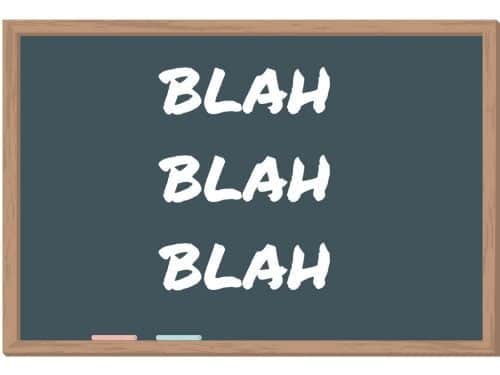It was painful to sit through. A while back, I was listening in on an academic’s interview with a journalist. Each answer was probably about eight minutes long as he segued from one topic to the next without giving the journalist an opportunity to interject. He was going on and on, flippantly using big words that the average person would need to look up. His points were communicated in a dry and boring way.
This is problematic for many reasons.

It muddles your message. How can a journalist communicate your key point if you’ve communicated 18 different messages during an interview?
It can also lead to a greater likelihood of being misquoted. Journalists are often thrown under the bus by academics for misquoting their work. There are some journalists who do misquote intentionally so that a source’s comments go in a certain pre-determined direction. From my experience, I usually see misquotes resulting from poor communications tactics (like rambling).
You have wasted the journalist’s – and your – time. If you can say the same thing in 30 seconds as opposed to 5 minutes, you just wasted 4 minutes and 30 seconds. As a result, you are unlikely to be called upon by the journalist again.
You also wasted a golden opportunity. Media visibility is a great way to reach audiences at no financial cost (unless using a PR firm). These opportunities are difficult to obtain as we are seeing a shifting media landscape. Rambling on and on squanders this opportunity.
TIPS TO CONSIDER
It is easier said than done to communicate a clear message in an interview. Usually, the less amount of time you have to make a point requires more preparation in advance. Whether you are an academic, subject matter expert or a communicator coaching a colleague, take into the account the following when communicating to a journalist or blogger.
1) Focus on no more than three messages. Back up each message with stories, examples, data and other supporting information that make your messages memorable. Make sure to raise those messages during the interview, even if you aren’t directly asked. Remember your A, B, Cs: Answer a question, form a Bridge and then Conclude with your key points.
So for example, let’s say you have interesting research on how charitable organizations can increase the likelihood of generating donations. You are asked during an interview what federal policies can be implemented to increase donations, which really isn’t your expertise. You could respond the following: “Clearly in behavioral science, there are measures that policymakers can deploy to encourage citizens to make donations to charities. But our research is focused really on what organizations can do on their own without government assistance to move the needle in this area. Organizations can control their own destiny and we learned in our work that using behavioral science tactics like anchors – providing an initial piece of information to make subsequent judgments – increases donations by XYZ percent. An example of this is …….” In this case, the sentence that begins “But our research is focused” is the bridge that then connects to key messages.
2) Be conversational. Many look at media interviews as a pure Q and A format. Sure, the journalist is asking the researcher / expert the question, but this can be done in a conversational way so that the journalist is engaged and can fully comprehend the issue being discussed. So as opposed to stating directly that our educational system doesn’t focus on how to ask the right questions, the interviewee can ask the journalist the following: “SO XYZ journalist – let me ask you a question. How much of your primary education was focused on learning the right answers as opposed to asking the right questions?”. This involves the journalist in the discussion and reduces those mini 8-minute lectures in answers to questions that I alluded to in the opening example of this blog post.
3) Eliminate jargon. This is tricky as often times we think certain terms and phrases are known to everyone because we use them in various circles on a regular basis. In my opinion, there is also a unspoken perception among some that bigger words means we are smart and intellectual. It is actually quite the contrary, my friends. I believe that the ability to communicate complex ideas in a clear and concise way is an intellectually rigorous process. If you scroll through the New York Times best-selling non-fiction authors, you will see a commonality: they all are able to communicate in a clear and engaging way. Ditto for many of the experts and thought leaders that are frequently quoted in the media within the niches we follow. To eliminate jargon, focus on the 3 S’s: be short, simple and integrate stories.
In creating the curriculum for my media training workshops, I asked a former colleague who is particularly adept at communicating complex ideas to the media – Duke Professor Campbell Harvey – to share advice on communicating to journalists. He said the following: “What I usually do is to compare a complicated situation to a simple situation that the audience can understand. For example, in explaining the largest heist in history, the Mt. Gox bitcoin theft, I said that ‘Mt. Gox was like your community bank … except there were no tellers or security personnel, no cameras, and a vault full of cash with the door wide open.’” This is a great example of being short, simple and using a story to make a point.
There are other nuances that go into successful media interviews and different formats require different tactics (i.e. – there are different variables at play when doing a telephone interview with a print journalist for a trend story vs. an in-depth podcast interview focused on your work). I encourage you to take into account these three principles regardless of format. It will help you secure positive visibility and potentially position you to be the go-to source for media, leading to visibility on an ongoing basis.
This article was written by Kevin Anselmo, Founder of Experiential Communications. Learn more about Experiential Communications’ Media Training for Academics program.

